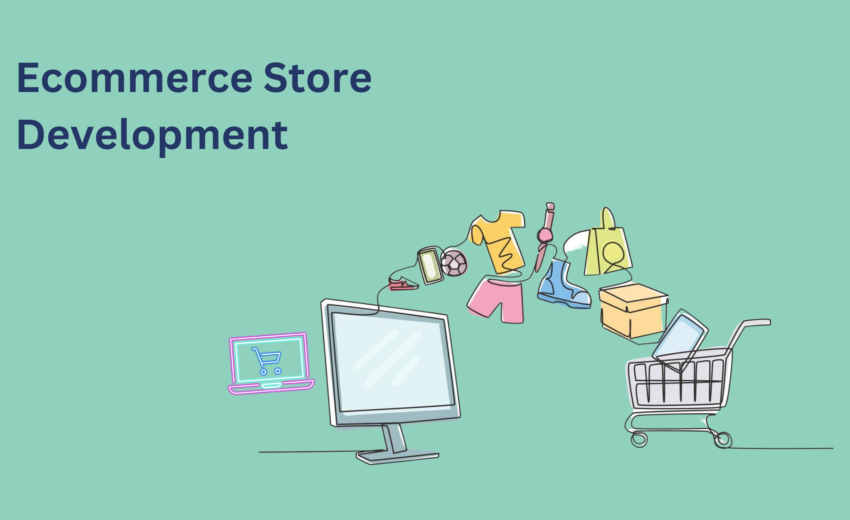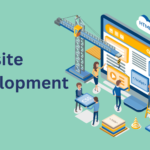
Nearly 15% of sales occur online, which is growing rapidly as internet shopping continues to dominate the worldwide retail business. It is critical for your small business to have a well-developed e-commerce website if you want to ride this wave.
A well-designed online shop is more than just pretty to look at. If done right, it will increase revenue and profit for your online store by making placing orders easier for clients and establishing your brand as a reliable one.
Outline of Materials
- What is E-commerce web development?
- How to build an online store: a step-by-step guide
- What makes an online store successful?
- Strategies for Creating an Online Shop
- How to work with an e-commerce website developer
- A website is the foundation of your online store.
- Development FAQ for Online Shops
What is E-commerce web development?
Developing an e-commerce website entails constructing an online marketplace where goods and services can be bought and sold. It entails making shopping easier for customers by creating and constructing intuitive interfaces, incorporating safe payment channels, managing product catalogs, and introducing new functions.
What’s in it is:
- Making a Website
- Catalog of products
- Shopping Cart
- Connecting to a Payment Gateway
- Security
- Search Engine of Optimization
- Mobile responsiveness
- Customer service
Developing an e-commerce website means creating a safe and simple system for conducting business online. More purchases and conversions will result from the increased trust displayed to site visitors.
How to build an online store: a step-by-step guide
From defining your company’s digital persona to constructing the actual site, the e-commerce website development process encompasses a wide range of activities.
Establish your Brand:
Establishing a brand in the online retail space calls for some critical thinking. First, is your business a business-to-business ( B2B) or business-to-consumer (B2C) operation?
Your e-commerce site’s visual aesthetic and level of product description content should be crafted around the preferences of your ideal customer. Finally, you need to think of a catchy name for your company, one that will stick in people’s minds and accurately convey your brand’s values.
Get a website name.
When picking a name for your online store, you should also consider whether that name is already taken. Shopify makes it simple to purchase a domain name for your online store, but popular domains might sell out quickly, so if the one you want is still available, you should get it while you still can (you can always choose a one- or two-year contract if you’re not ready to commit long-term).
Before deciding on a company name, you may wish to research the availability of relevant domain names to maximize traffic to your e-commerce site and build brand recognition.
Choose an appropriate web host.
After acquiring your domain name, the next step in getting your website up and running is to select a web host, ideally one that also provides an e-commerce platform.
While some hosting services provide only the bones upon which your website might be developed, others provide templates that are both user- and mobile-friendly.
Design your site:
Your website’s design, beyond a recognizable logo and eye-catching color palette, should effectively convey your business’s aims.
The success of your e-commerce venture hinges on the usability of your online store; therefore, build it with the user experience in mind. Lost sales and tarnished reputations might be the result of a poorly designed website or a difficult checkout process.
Consider the sleep aid Kulala. Its website is well-designed in terms of aesthetics, with a nice color scheme, a clean and modern font, and uniform styling throughout.
Kulala’s minimalist design allows users to concentrate on the content without distractions. Simplifying anything usually entails paring it down to its barest essentials.
Determine how orders will be fulfilled
Which method of e-commerce order processing are you going to use? Which is better, in-house fulfillment, dropshipping (where goods are ordered directly from suppliers on behalf of clients), or third-party logistics (where fulfillment processing is completely outsourced)?
These metrics will guide your order capacity and, in turn, your website layout. Advertisements should provide customers with a clear idea of when they can anticipate their orders to arrive; this is especially important if you’re using a third-party logistics firm and they have a set delivery window.
Create a website and publish it.
To save a fortune on web design and development, you may choose to make your own e-commerce website using a prefab method, such as Shopify’s drag-and-drop content blocks and image placeholders.
With some additional funds, you can still hire a developer to create your website while using a hosting platform like Shopify, and then migrate the site over.
Launching your website is the next step after its creation. But first, you should run some tests to make sure everything is in working order. Before launching, make sure you’ve thoroughly tested the site’s functionality, including its speed, its mobile-friendliness, and its checkout procedure.
Install Google Analytics or an equivalent tracking tool. In this method, you can track your site’s stats and make informed judgments on how to enhance them.
Keep up with your webpage.
The stock and product offerings on your e-commerce site, as well as any discounts or special offers, will need to be continuously updated.
You or your visitors may discover that certain features or components of your website design are inadequate or that adjustments must be made in response to user input. The layout of an online store can be modified instantly, unlike physical stores.
Shopify’s drag-and-drop website builder makes it simple to make alterations to your site.
A great online storefront is a continuous endeavor that adapts and expands with your company.
What makes an online store successful?
The code and safety measures behind an e-commerce site’s clickable elements and checkout process are just as important as the features themselves.
Good UI/UX:
The design of the user interface (UI) and the user experience (UX) are crucial to the success of any online store. A strong e-commerce UI/UX should have filters that help customers quickly find the product or range of products they’re looking for, a search bar, a streamlined aesthetic, and easily readable content.
Consider Gymshark as an illustration. It’s neat, uncluttered, and simple to use. The site is easy to navigate, so customers can quickly find the goods they need. In addition, a search bar allows for faster, more targeted inquiries.
The site’s design is responsive, so it looks good on mobile devices of all sizes. With more and more people making purchases online, this is an important feature to have.
In order to help users figure out what to do next, Gymshark includes prominent calls to action. Plus, there aren’t a lot of hoops to jump through during checkout, so customers are less likely to give up on their purchases halfway through.
Safe and sound online:
It is crucial that your online shop, as well as any information it handles or stores, is protected. Customers’ credit card numbers and mailing addresses are among the most private pieces of information in the world, yet you have access to them.
Implementing “transport layer security” (TLS), “secure socket layers” (SSL), and HTTPS authentication—programs that authenticate and encrypt links between customer computers and your site—are all recommended best practices for e-commerce customer security. You can take measures to guarantee that all company computers and mobile devices are equipped with anti-virus and malware protection.
Online marketplaces that encrypt client data, such as Manitobah, are a step forward in safety. A TLS certificate has been issued if the URL begins with https:// and a padlock icon appears next to the store’s URL.
The Best Mobile Experience Ever
Smartphone use is steadily increasing among internet users. As a result, online buyers are spending more and more time on their mobile devices.
By automatically adapting your desktop site to a mobile screen resolution, responsive design is a fantastic method for improving your site’s mobile experience. Any site designer you engage in 2023 should have the modern abilities to give this design feature on request; this is because most DIY web design providers, such as Squarespace and Wix, offer responsive design by default.
The mobile site for Colurpop is not only attractive but also fully responsive, making it ideal for anyone using their phone. The site’s layout and functionality are both maintained even when viewed on mobile devices.
It has a user-friendly interface that allows shoppers to quickly navigate between the many sections of the store and locate the items they need.
The mobile site is easy to navigate and loads quickly, making for a pleasant purchasing experience. A strong mobile UX includes fast loading speeds, as slow ones might frustrate consumers and cause them to abandon the site.
SEO:
By increasing your site’s visibility in search engines, search engine optimization (SEO) can boost your product sales (conversion rate).
Incorporating specific keywords into your site’s copy or product descriptions is one content strategy and approach you can use to boost your site’s visibility in relevant search results.
Superior images of the product:
Customers can more easily imagine owning your product with the help of photos, which improves consumers’ confidence in your items and the overall shopping experience, which in turn can boost revenue.
Let’s pretend there are two online shops offering the same item at roughly the same price.
Store A’s photos are blurry and dark since they were taken with a smartphone. Not being able to see the product from numerous perspectives makes it difficult to form an opinion about it.
Now think about Shop B, Homesick, which advertises its candles with eye-catching product photography.
The lighting is just right, really bringing out the best in the product. The product can be viewed from several perspectives, allowing customers to examine it in great detail.
Hire a professional product photographer if you lack the knowledge or resources to take adequate pictures of your goods. They can assist in bringing out the finest qualities of your merchandise.
Smooth checkout flow
Lost revenue is one possible outcome of a poor checkout experience. Customers may decide not to buy from you if you make them go through a lengthy sign-up process before making a transaction. Think of implementing a guest checkout option that lets customers make purchases with minimal effort (and information shared).
One-click checkout is a time-saving alternative to loading a shopping cart that can be offered to consumers who have previously signed up for your site and whose credit card information is already stored with you (securely!).
Customers can sign up in a flash by connecting their Facebook or Google accounts, and you can accept third-party payment methods like Shop Pay and Apple Pay.
Strategies for Creating an Online Shop
Several platforms exist on which to construct online marketplaces. Let’s compare them to find out which one suits you best.
- E-commerce website builders: Shopify-style platforms are great for newcomers and those in a hurry to launch an online store. E-commerce capabilities such as payment gateway connections, search engine optimization (SEO) tools, and inventory management are pre-installed, and no coding experience is necessary.
- Businesses with complicated content requirements, such as blogging or site architecture, may benefit from a content management system (CMS) with an e-commerce plug-in, such as WordPress with WooCommerce. These platforms require considerable technical knowledge to operate, especially for customization, but they provide this feature via plug-ins.
- Open-source e-commerce systems: Magento and PrestaShop are great examples of scalable, flexible platforms that can be tailored to the demands of even the largest organizations. They provide you with total control over your site but are more difficult to set up and keep up-to-date. You’ll often be responsible for hosting and security on open-source systems.
- Websites that have been designed specifically for a client allow for the most freedom and flexibility in terms of design and functionality. It’s the most difficult to develop and the most costly alternative.
Your organization’s size, budget, level of technical expertise, time available for website maintenance, and other factors will determine the best option. e-commercee-commercee-commerce When deciding how to effectively create your e-commerce website, keep all of this in mind.
How to work with an e-commerce website developer
Hiring a professional e-commerce developer can improve productivity and results. Shopify Experts is one such marketplace where you can find and hire a freelancer or an agency.
In the event that you decide to hire e-commerce web developers, consider the following advice:
- Share the big picture of your project by outlining its purpose, intended audience, desired features, and expected completion date.
- Explain your brand’s products and services in-depth, as well as the atmosphere you hope to establish.
- Talk to the developer ahead of time to make sure your spending plan is reasonable.
- Give them constant feedback, but don’t shut the door on their input.
- Talk about what you can do to keep the site running smoothly once it is live.
Cooperation, coordination, and forethought are the keys to success when working with an e-commerce developer. With such features in place, you can rest assured that your e-commerce platform will help you achieve your objectives.
Browse Shopify Experts to locate a programmer who is interested in helping your Shopify store succeed.
A website is the foundation of your online store.
One of the most important parts of growing your online store is creating a user-friendly and functional website.
In order to make the best decisions for your business, from picking a domain name to deciding whether or not to hire a third-party developer, you must first do a thorough analysis of your company’s requirements and objectives.
Development FAQ for Online Shops
Do you need a developer to create an online store?
You can easily design and develop your own e-commerce website using web-building tools, but if you have the funds, you may want to hire a developer to build you a world-class, completely custom website.
How do I create an e-commerce site?
To create an e-commerce website, you must first identify your business’s objectives and intended audience. Use a platform such as Shopify or employ a web developer to create a custom store afterward. Include essential features like product catalogs, purchasing carts, payment gateways, and user accounts.











